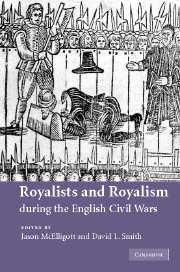Book contents
- Frontmatter
- Contents
- Notes on contributors
- Preface
- Abbreviations
- 1 Introduction: rethinking royalists and royalism
- 2 A lesson in loyalty: Charles I and the Short Parliament
- 3 The Court and the emergence of a royalist party
- 4 Varieties of royalism
- 5 Royalist reputations: the Cavalier ideal and the reality
- 6 Counsel and cabal in the king's party, 1642–1646
- 7 ‘I doe desire to be rightly vnderstood’: rhetorical strategies in the letters of Charles I
- 8 Royalists and the New Model Army in 1647: circumstance, principle and compromise
- 9 The royalist origins of the separation of powers
- 10 ‘A No-King, or a New’. Royalists and the succession, 1648–1649
- 11 The royalism of Andrew Marvell
- Subject Index
- Author Index
10 - ‘A No-King, or a New’. Royalists and the succession, 1648–1649
Published online by Cambridge University Press: 19 July 2009
- Frontmatter
- Contents
- Notes on contributors
- Preface
- Abbreviations
- 1 Introduction: rethinking royalists and royalism
- 2 A lesson in loyalty: Charles I and the Short Parliament
- 3 The Court and the emergence of a royalist party
- 4 Varieties of royalism
- 5 Royalist reputations: the Cavalier ideal and the reality
- 6 Counsel and cabal in the king's party, 1642–1646
- 7 ‘I doe desire to be rightly vnderstood’: rhetorical strategies in the letters of Charles I
- 8 Royalists and the New Model Army in 1647: circumstance, principle and compromise
- 9 The royalist origins of the separation of powers
- 10 ‘A No-King, or a New’. Royalists and the succession, 1648–1649
- 11 The royalism of Andrew Marvell
- Subject Index
- Author Index
Summary
In the autumn and winter of 1648–9 Charles I came as close as he would ever come to negotiating a peace with the rebellious Westminster Parliament. As usual, his willingness to talk peace was just one element in a strategy of war. Militarily, the king's best-laid plans once again lay in ruins, strewn across the northern counties of England with the remnants of the Scots army of the Engagement. But with a fleet of warships still at his son's disposal, and an alliance with the Irish confederates still a possibility, the king's hopes were little diminished. Politically, his prospects remained good, and in order to take advantage of the differences within the parliamentarian coalition he agreed to sit down with his adversaries. Believing that he could negotiate without in fact committing himself to anything, the king apparently abandoned power, authority and even his principles. His objective was to dupe his opponents, either into allowing him to return to his capital to conclude the deal, or else to permit him sufficient personal freedom to engineer an escape. But unaware of his calculations, or else unconvinced of their wisdom, some of the king's closest supporters found the seemingly imminent prospect of a peace without honour or security hard to reconcile with the best interests of either the crown, the church, the House of Stuart, or indeed themselves.
- Type
- Chapter
- Information
- Royalists and Royalism during the English Civil Wars , pp. 192 - 213Publisher: Cambridge University PressPrint publication year: 2007



